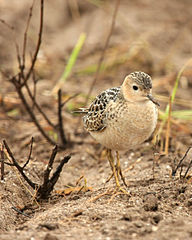The Committee on the Status of Endangered Wildlife in Canada (COSEWIC) held their spring species assessment meeting last week in the Kananaskis Valley of Alberta. The committee considered the status of 35 wildlife species, including five birds.
Buff-breasted SandpiperTryngites subruficollis
Range YT NT NU BC AB SK MB ON QC
The Canadian Arctic supports about 87% of the North American breeding range of this shorebird, and about 75% of its global population. The species was once common and perhaps even abundant historically, but it suffered severe declines stemming from intensive market hunting in the late 1800s and early 1900s. By the 1920s, it was thought to be at the brink of extinction. Its population has grown since hunting was banned in North America, but numbers remain much lower than those before hunting began. There is evidence for population decline in recent decades, and many conservation organizations consider the species to be of concern throughout its range. However, this species is difficult to monitor effectively, and data necessary to estimate population trends are currently lacking. Outside the breeding period, loss and degradation of its specialized grassland habitat, both on its wintering grounds in South America and along its migration routes, are believed to pose the most significant threats.
- Designated Special Concern in May 2012.
Marbled Murrelet Brachyramphus marmoratus
Range BC
This small seabird is largely dependent on old growth coastal forests in British Columbia for nesting. Habitat loss has been estimated at over 20% for the past three generations. Future threats including ongoing habitat loss, coupled with increased threats from proposed shipping routes in the core of the species’ range, increased fragmentation from a variety of proposed and recently initiated developments, fisheries bycatch and changing at sea conditions have resulted in projected population losses exceeding 30% over the next three generations
- Designated Threatened in April 1990. Status re-examined and confirmed in November 2000 and May 2012.
Western Screech-Owl kennicottii subspecies
Range BC
This small owl has shown serious declines in the southern part of its range in Metro Vancouver, Victoria and the Gulf Islands areas, where it has nearly disappeared over the last 10 to 15 years. Based on observed declines reported in Alaska, it has likely also declined in the northern part of its range, but the magnitude of the decline is unknown. The population is thought to be relatively small (less than 10,000 adults) and the owls face ongoing threats including predation from newly established populations of Barred Owls, and the removal of dead trees and snags, which serve as nest sites and roosts.
- Species considered in April 1995 and placed in the Data Deficient category. It was split according to subspecies in May 2002. The kennicottii subspecies was designated Special Concern in May 2002. Status re-examined and designated Threatened in May 2012.
Western Screech-Owl macfarlanei subspecies
Range BC
The Canadian population of this owl is small, numbering between 350 and 500 adults, but is larger than previously estimated based on recent survey effort and has a much wider range in southern British Columbia than previously thought. The population has been apparently stable over the last 10 years, but faces ongoing threats especially from the loss of mature trees needed for nesting and roost sites. The loss of these trees is associated with urban and agricultural developments and degradation of riparian woodlands.
- Species considered in April 1995 and placed in the Data Deficient category. It was split according to subspecies in May 2002. The macfarlanei subspecies was designated Endangered in May 2002. Status re-examined and designated Threatened in May 2012.
Baird’s Sparrow Ammodramus bairdii
Range AB SK MB
Canada supports about 60% of the breeding population of this prairie songbird. The species was common and perhaps even abundant historically. It suffered declines stemming from agricultural conversion of its native prairie habitat across the Great Plains. There is good evidence for population declines in recent decades, but the species is difficult to monitor effectively, and information on short-term population trends is relatively weak. Loss and degradation of its specialized grassland habitat, on both its breeding and wintering grounds, are believed to pose the most significant threats. Evidence of long-term population declines, coupled with ongoing threats to habitat, are the primary reasons for elevating the status of this species from Not at Risk to Special Concern.
- Designated Threatened in April 1989. Status re-examined and designated Not at Risk in April 1996. Status re-examined and designated Special Concern in May 2012.
Hooded WarblerSetophaga citrina
Range ON
In Canada, the range and abundance of this forest-nesting species have increased substantially since the species was last assessed. The species has also experienced a significant long-term increase in abundance in the core of its range in the United States, so there is an outside source for rescue. However, habitat degradation at breeding sites and habitat loss and degradation at migration stopover sites and on the wintering grounds are potential threats.
- Designated Threatened in April 1994. Status re-examined and confirmed in November 2000. Status re-examined and designated Not at Risk in May 2012.



